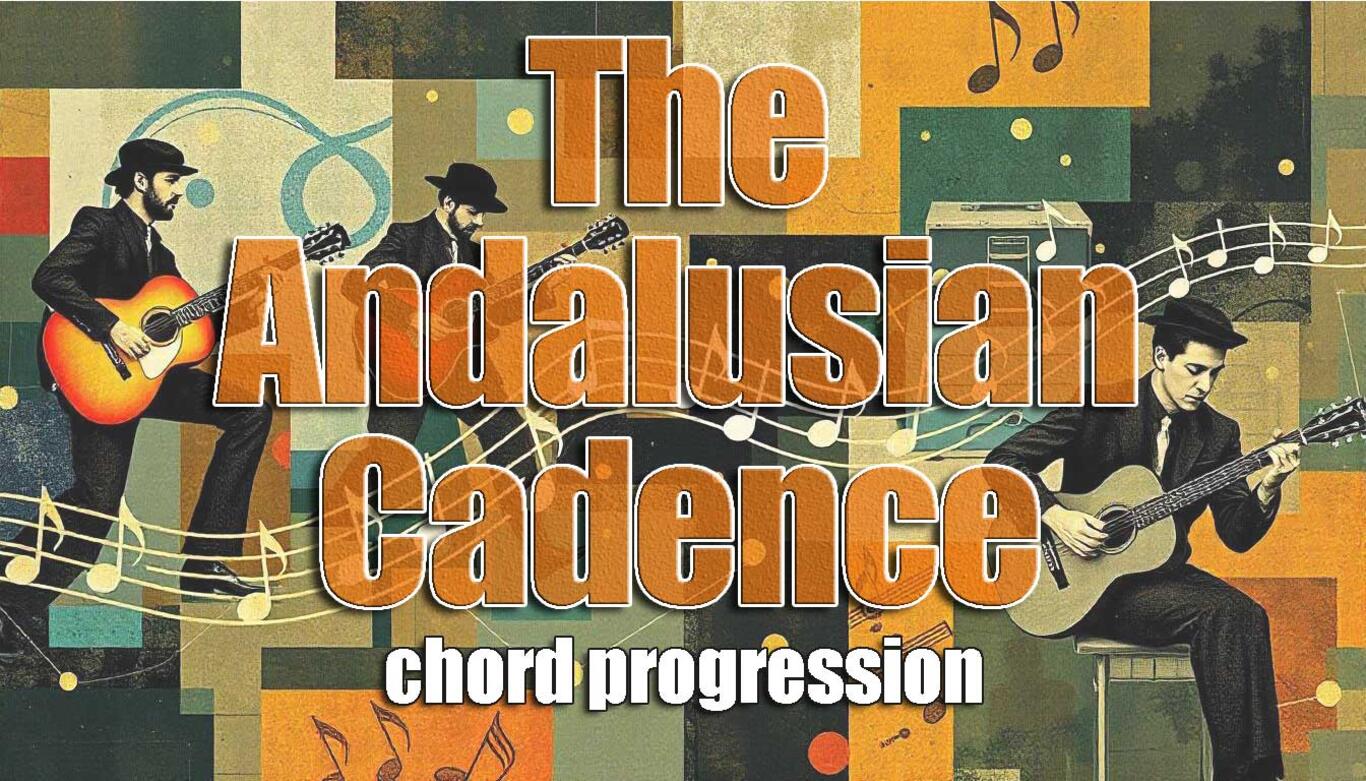The Andalusian Cadence: What It Is, Why It Works, and Famous Pop Tunes That Use It

Press Play to hear The Andalusian Cadence
The Andalusian cadence is a captivating and widely-used chord progression that has deep roots in traditional Spanish, Latin, and Western music. It’s especially prominent in Flamenco but has also found its way into modern genres, from pop and rock to jazz and electronic music. Characterized by its minor descending progression, the Andalusian cadence creates an emotional, often dramatic feel, making it a favorite among composers and songwriters looking to evoke passion or melancholy.
Famous Songs That Use the Andalusian Cadence
Many well-known songs across genres have successfully used the Andalusian cadence, either in its traditional form or with slight variations. Here are some examples of famous tunes that showcase the power and versatility of this progression:
1. “Hit the Road Jack” by Ray Charles
- Key: A minor (Am - G - F - E)
- This classic uses the Andalusian cadence to drive its infectious rhythm and create its distinctive, memorable hook. The i-VII-VI-V progression serves as the foundation for the song’s call-and-response structure, with Ray Charles’s vocal delivery bringing the cadence to life.
2. “Stray Cat Strut” by Stray Cats
- Key: D minor (Dm - C - B♭ - A)
- This rockabilly hit makes prominent use of the Andalusian cadence, with its slinky, descending chords giving the song its cool, laid-back vibe. The progression perfectly complements the song's lyrics about a streetwise, carefree character.
3. “Don’t Let Me Be Misunderstood” by Nina Simone / The Animals
- Key: E minor (Em - D - C - B)
- Both Nina Simone’s original and The Animals’ famous rock cover feature the Andalusian cadence prominently. The descending progression creates a sense of tension and emotional urgency, underscoring the song’s theme of misunderstanding and frustration.
4. “Sultans of Swing” by Dire [email protected]("Dire Straits")
- Key: D minor (Dm - C - B♭ - A)
- This iconic Dire Straits track uses the Andalusian cadence to build its bluesy, laid-back feel. The descending motion of the chords works beautifully with Mark Knopfler’s intricate guitar work, providing a steady harmonic backdrop for his improvisations.
5. “Bamboleo” by Gipsy Kings
- Key: F
- The Gipsy Kings' "Bamboleo" is a direct nod to the Andalusian cadence’s Flamenco roots. The progression's dramatic descent drives the song’s infectious energy and fiery intensity, showcasing its effectiveness in more upbeat, rhythmic contexts.
6. “Hava Nagila” (Traditional)
- Key: A minor (Am - G - F - E)
- The traditional Jewish folk song "Hava Nagila" uses the Andalusian cadence to great effect. The descending harmonic structure reinforces the song’s celebratory yet somewhat reflective mood, making it a powerful anthem for gatherings and celebrations.
7. “And I Love Her” by The [email protected]("The Beatles")
- Key: E minor (Em - D - C - B7)
- In this classic Beatles ballad, the Andalusian cadence is present in the guitar accompaniment. The descending chords mirror the tender emotions of the lyrics, creating a sense of romantic longing and vulnerability.
8. “Runaway” by Del Shannon
- Key: A minor (Am - G - F - E)
- Del Shannon’s "Runaway" uses the Andalusian cadence to underpin the song’s catchy, melancholy melody. The descending progression reflects the song’s themes of lost love and regret, while the up-tempo rhythm ensures it remains upbeat and danceable.
9. “Misirlou” (Traditional) by Dick Dale
- Key: E minor (Em - D - C - B7)
- This traditional Middle Eastern tune, famously popularized by surf guitarist Dick Dale, uses the Andalusian cadence to create a driving, hypnotic rhythm. The descending progression helps to build intensity and drama, making the song a surf rock classic.
10. “Stairway to Heaven” by Led Zeppelin (Intro)
- Key: A minor (Am - G - F - E)
- The introduction to Led Zeppelin’s iconic “Stairway to Heaven” uses the Andalusian cadence, with the descending chords setting the stage for the epic journey that unfolds. The tension created by the progression contributes to the song’s mystical, otherworldly atmosphere.
- Good Vibrations by the Beach Boys
- Citizen erased by Muse
- Summer in the City by Quincy Jones
- Happy Together by the Turtles
What Is the Andalusian Cadence?
The Andalusian cadence is a descending chord progression that follows this formula:
- i - ♭ VII - ♭ VI - V
In this progression, each chord is a diatonic chord based on the natural minor scale, meaning all the chords belong to the same key. Here's how it breaks down in a few common keys:
- In the key of A minor, the Andalusian cadence would be:
Am (i) - G (VII) - F (VI) - E (V)
- In the key of E minor:
- Em (i) - D (VII) - C (VI) - B (V)
This descending motion of the chords (from i to VII to VI to V) creates a strong, almost hypnotic feel, which is why it is often associated with Flamenco music. The resolution from the dominant V chord back to the tonic minor (i) provides a satisfying close to the phrase while retaining an air of intensity.
Why Does the Andalusian Cadence Work?
The Andalusian cadence works so effectively because it draws on time-honored harmonic principles while offering a distinctive emotional impact. Several factors contribute to its power:
1. Descending Bass Line
One of the defining characteristics of the Andalusian cadence is the descending motion of the bass line. This descent from the tonic (i) to the dominant (V) creates a sense of inevitability and resolution, which draws the listener in. Even though the harmony moves through major chords (VII and VI), the steady downward bass line lends a melancholic feel to the progression.
2. Mix of Major and Minor Chords
The progression balances the tension between major and minor chords. Starting with the minor i chord sets a somewhat introspective, solemn tone, but the major chords (VII and VI) that follow brighten the progression, adding a sense of hope or grandeur. The V chord (often a dominant major chord) then introduces tension that resolves back to the tonic minor, bringing the progression full circle.
3. Cultural and Historical Resonance
The Andalusian cadence has deep roots in the music of southern Spain, especially in Flamenco and other traditional styles. It evokes a sense of longing and passion, emotions that are often linked to Spanish and Latin music.
4. Universal Appeal and Versatility
Despite its origins in Flamenco, the Andalusian cadence is highly versatile and has been adapted into numerous musical genres. Its simple yet effective structure makes it easy to integrate into various forms of music, whether that’s classical, jazz, pop, or rock.
Conclusion
The Andalusian cadence is a powerful and versatile chord progression that has left a significant mark on Western music, from traditional Spanish Flamenco to modern pop and rock. Its descending bass line and the mixture of major and minor chords give it a unique emotional depth, making it suitable for expressing a range of feelings, from passionate longing to intense drama.




